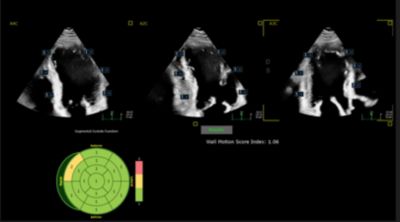
First-of-kind automated segmental wall motion assessment of the left ventricle
- By | |
- August 11 2025
- 2 min read
First-of-kind automated segmental wall motion assessment of the left ventricle
Left ventricular (LV) wall motion abnormalities are an independent indicator of adverse cardiovascular events and death in patients with cardiovascular diseases such as myocardial infarction, dyssynchrony and congenital heart disease [1,2]. Accurate assessment of regional wall motion abnormalities (RWMA) is critical in identifying acute and chronic myocardial infarction, as well as in differentiating ischemic from nonischemic causes. A new, AI-based tool, Auto Segmental Wall Motion Scoring (Auto SWM), can provide fast and objective assessment of left ventricle RWMA.
At-a-glance:
- New tool automatically suggests wall motion scores for the left ventricle
- Simple, fast four-step workflow generates scores that are reviewed and approved or modified by the user
- A validation study showed correlation between the automatically generated wall motion score index (WMSI) and the assessment of board-certified cardiologists

Recent studies that investigated the prognostic value of the wall motion scoring index (WMSI) in patients with acute myocardial infarction have suggested superiority to left ventricular ejection fraction in predicting mortality [3-5]. Another study suggested that WMSI is superior to LVEF in predicting 12-month mortality in ST-segment elevation myocardial infarction (STEMI) patients treated with primary percutaneous coronary intervention (PCI) [6].
Automatic wall motion scoring
The robust Auto SWM assessment tool, embedded on the ultrasound system within the 2D Auto LV application, provides fast and objective assessment of LV RWMA. Auto SWM is a first-of-kind application that automatically suggests a wall motion score for the left ventricle.
Segment classification
The tool uses a machine-learning model to assess velocity, displacement and strain for each of 17 segments pertaining to the LV. Based on these calculations, it then classifies the segments into one of three categories: normal, hypokinetic or akinetic. Artificial Intelligence determines a score for 16 LV segments, and the final segment is calculated as an average of the four apical segments.
Simple workflow
The simple, four-step workflow begins with image acquisition and includes a manual review and acceptance of results. (Figure 1)
Validation study demonstrates value
A validation study performed on retrospective data compared the automatically generated WMSI from the Auto SWM application to a visual assessment from a consensus panel of four board-certified cardiologists. In total, automated analysis was possible in 143 of 161 (89%) of exams. The correlation between reference WMSI and automatically-calculated WMSI is show in figure 2.
Copy this URLto share this story with your professional network
Footnotes
- Carluccio E, Tommasi S, Bentivoglio M, Prosciutti L, Corea L. Usefulness of the severity and extent of wall motion abnormalities as prognostic markets of an adverse outcome after a first myocardia infarction treated with thrombolytic therapy. Am J Cardiol. 2000;85:411-5.
- Cicala S, de Simone G, Roman MJ, et al. Prevalence and prognostic significance of wall-motion abnormalities in adults without clinically recognized cardiovascular disease: the Strong Heart Study. Circulation. 2007 July 10;116(2):143-50.
- Juardo-Román A, Aguado-Quílez P, Rubio-Alonzo B, et al. Superiority of wall motion score index over left ventricle ejection fraction in predicting cardiovascular events after an acute myocardial infarction. Eur Heart J Acute Cardiovasc Care. 2019 Feb;8(1):78-85.
- Kan G, Visser CA, Koolen JJ, Dunnig AJ. Short and long term predictive value of admission wall motion score in acute myocardial infarction. A cross sectional echocardiographic study of 345 patients. Br Heart J. 1986 Nov;56(5):422-7.
- Xiang L, Wang M, You T, Jiao Y, Chen J, Xu W. Prognostic value of ventricular wall motion score and global registry of acute coronary score in paitents with acute myocardial infarction. Am J Med Sci. 2017 Jul;354(1):27-32.
- Savage ML, Hay K, Anderson B, et al. The prognostic value of echocardiographic wall motion score index in ST-segment elevation myocardial infarction. Crit Care Res Pract. 2022 Nov 10;2022:8343785.
Disclaimer
Results are specific to the institution where they were obtained and may not reflect the results achievable at other institutions. Results in other cases may vary.